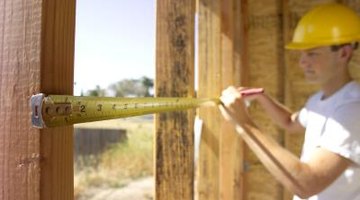Carpentry Math Problems
Most carpentry tasks involve measuring to increments of whole inches, or fractions of inches. And standard tape measures that carpenters use are graduated in 16ths of an inch. Going from the smallest to the largest graduations on a carpenter's tape measure, there are 16th, eighths, quarters, halves and whole inches. A tape measure is also marked in feet, with 12 inches to each foot. Because 16 inches is a standard distance between vertical framing studs in the building industry, a carpenter's tape measure typically also has flagged markings at 16-inch intervals.
Linear Measurements

Perhaps the most common math problem in carpentry is figuring linear measurements. One common task entails dividing a linear measurement exactly into two halves. It's fairly evident that half of 10 inches is 5 inches, and that half of 8 inches is 4 inches. But in carpentry it's very common to have to divide fractions in half also.
An example would be to measure and cut a 10 1/2-inch board exactly in half. Half of 10 is five, but what is half of a half? There is a simple rule of thumb that works every time. In a fraction there is the top number, or numerator, a dividing horizontal line or a forward slash, then a bottom number, or denominator. The fraction one-half is a "1" with a line under it or a forward slash after it, and a "2" below the line or after the slash. The rule for dividing a fraction into two equal parts is to double the denominator. So half of one-half is one-quarter, half of one-quarter is one-eighth, and half of one-eighth is one-sixteenth. So half of 10 1/2 inches is 5 1/4 inches.
Square Measurements
Frequently in carpentry there's a need to make square measurements. One example would be in figuring out how many sheets of plywood are necessary to cover a floor. Plywood is typically available in sheets that measure 4 by 8 feet. Calculating square measurements entails multiplying length by width. A rectangular floor surface measuring 20 feet in width and 30 feet in length would be 600 square feet. Since each 4 by 8 foot sheet of plywood measures 32 square feet, dividing 600 by 32 gives the number of sheets of plywood needed. Having waste materials in carpentry is virtually unavoidable, but carpenters do work to minimize it. In this plywood example it turns out to be 18.75 sheets of plywood. In practice, the carpenter would probably buy at least 19 sheets of plywood.
Cubic Measurements
To illustrate a carpentry math problem in cubic measurements, a woodshed project serves well. Since firewood is measured in cords, and each chord is 128 cubic feet, a woodshed intended to hold one cord would need to have 128 cubic feet of internal space. So a woodshed with internal dimensions of 8 feet wide, 4 feet deep and 4 feet high will hold one cord of wood. That's because eight multiplied by four, and then again by four, equals 128.
Material Costs
It's a simple fact of life that carpenters have to consider the cost of materials. And different materials are priced in different ways. When buying 19 sheets of plywood, with each sheet costing $12, the total will be 12 times 19 or $228. In many cases the final cost of materials also includes a sales tax. So a percentage of the total price must be added to the final figure for a grand total, including tax. Each percentage point is one-one hundredth of the total cost. So a price of $100 and a sales tax of one percent would give a tax amount of $1. Similarly, a sales tax of five percent on a price of $100 would be $5 and the total price would be $105. In the plywood example, a 5 percent sales tax would yield a total price, including tax, of $239.40.
Other Problems
Linear, square and cubic dimensions cover the vast majority of math problems that arise in carpentry. But there are other, somewhat more advanced, challenges that can arise. Features like circles, cylinders and irregular shapes call for more rigorous geometric solutions. There are geometric formulas available to handle virtually any of these.
And, last but not least, the dimension of time can come into play. Often carpenters and customers are interested in how long a project will take to complete.
References
Writer Bio
Donald Miller has a background in natural history, environmental work and conservation. His writing credits include feature articles in major national print magazines and newspapers, including "American Forests" and a nature column for "Boys' Life Magazine." Miller holds a Bachelor of Science in natural resources conservation.
Photo Credits
- Brand X Pictures/Brand X Pictures/Getty Images
More Articles



